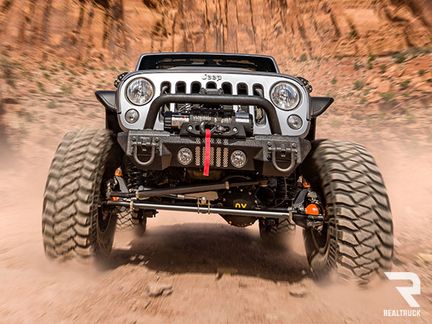Get up to $400 Off Truck Bed Covers – Shop Now
Jeep Stacking: What is It and Why do Jeepers do It?
Updated on Sep 18, 2024
Have you ever pondered the state of mind required to park one’s Jeep on top of another’s? While an odd symbol of endearment, Jeep stacking is just that: a show of respect.
But where does this iconic and seemingly Jeep-exclusive move come from? In this article, our experts dig into the roots and history of the Jeep Stack.
What is Jeep Stacking?
Jeep stacking is, in its own right, a sort of art form to the Jeep community. It’s the process of using another Jeep’s tire as an RTI ramp to show off your locker-stuffed front differential, your suspension’s articulation, and your prowess behind the wheel; after all, only an expert would dare park virtually on top of their buddy’s Wrangler.
Typically, Jeep stacking is performed not for yourself but for the enjoyment of others. It’s a way to set up the perfect car-show look or impromptu photo-op, whether parked at the end of the Rubicon, washed up for the show-and-shine, or posted up with your fellow Jeepers in a restaurant parking lot for a photoshoot (no shame, we’ve all been there).
Where did the art of Jeep stacking come from? Honestly, who knows? Whether it was an accidental occurrence while parking at a show or crowning a blind hill, the odds are it earned a photo, which spread through Jeep forums or social media sites like wildfire. Since then, a proper Jeep stack has become a right of passage. If your Jeep is built enough to manage a solid stack, you’ve made it.
Approach Angle
Approach angle is defined as the maximum upward angle of an inclined surface that your Jeep can climb; in Layman’s terms, this means the steepest object your Jeep can climb without making contact with the front bumper, axle, or any other part of the chassis.
While relatively capable in stock form, a Jeep’s approach angle can be improved substantially by increasing lift height, adding larger tires, and installing high-clearance bumpers. In Jeep stacking, a higher approach angle helps your Jeep to climb over the target tire without the bumper or chassis getting in the way.
Break-Over Angle
Break-over indicates the steepest angle your Jeep can climb over without making contact with the center of the body; basically, it’s the tallest obstacle your Jeep can pass over without high-centering.
Increased ground clearance is realistically the only thing that improves a Jeep’s break-over angle, which can be accomplished with a taller lift, low-profile or no steps, and oversized tires. However, this angle isn’t overly helpful while stacking unless you’re a touch overzealous and accidentally drive over the target tire.
Departure Angle
The departure angle is similar to your Jeep’s approach angle, except it focuses on the rear end rather than the front.
A high departure angle means your Jeep can climb up and down aggressive obstacles without dragging the rear bumper, fuel tank, hitch, etc. Like approach angle, departure angle is improved with lift kits, high-clearance rear bumpers, and oversized tires. While not directly correlating to Jeep stacking, your rear bumper could potentially drag in extreme conditions, like attempting to stack on a 40” tire.
While these numbers vary by generation and model, most stock Jeeps average approach angles in the low 40º range, break-over angles in the low 20º range, and departure angles in the low 30º range. Of course, these numbers can increase exponentially with upgrades like oversized tires, which you can achieve by researching proper Jeep tire size.
Tips to Stack Your Jeep
While we’ll tentatively recommend stacking due to the risk of suspension, body, and tire damage, we have a few tips to prevent pride-based repairs or injury:
Have the Proper Upgrades
Firstly, don’t try to stack a stock Jeep, especially not on a massive tire belonging to a heavily-modified rig. At a bare minimum, we’d recommend front and rear locking differentials, a lift, oversized tires, and high-clearance bumpers. Even then, you may incur a popped axle U-joint or damaged wheel bearing if you aren’t careful.
Have a Spotter
Don’t stack without proper guidance; one false move can easily damage your Jeep, the other driver’s rig, your reputation in the Jeep community, and your pride. So go slow, take your time, and back out if things get hairy.
Air Down
One of the best tips for a proper stack is the air down the climber’s tire. As with off-roading, airing down widens the contact patch and allows the tire to flow and flex over the obstacle for better traction; in this case, another tire. Just don’t air down too far if you’re running non-beadlock wheels (12–16 psi at the lowest).
Ask Permission
Before you cruise up another Jeep’s tire, just ask permission. It takes a second and can help shed some responsibility if, by chance, you end up causing damage to the other driver’s Jeep. It’s also a simple matter of courtesy.
Shop Now
RealTruck is your home for the best products to outfit your build for unforgettable adventures.
Miscellaneous Suspension Components | Interior Lights | Steering Upgrades
See More Jeep Wrangler Articles Here...
- …
Join over 2 million RealTruck people
Get exclusive savings, insider information, and the latest RealTruck articles sent straight to your inbox.



